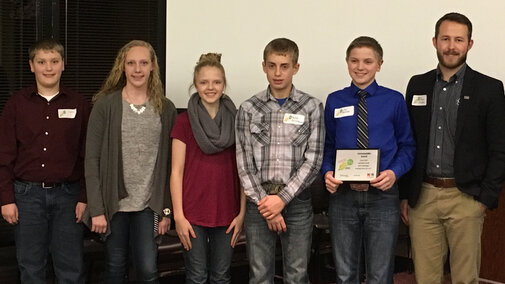Participants in this year's Innovative Youth Corn Challenge learned valuable lessons in production ag, research, teamwork, and problem-solving while competing for cash prizes made possible by the Nebraska Corn Board.



Corn Challenge Lays Foundation for STEM Careers
Science, technology, engineering, and math (STEM) careers are in high demand and will continue to be in future years. To engage youth in crop science based education, the Innovative Youth Corn Challenge (IYCC) was created as a partnership between the Nebraska Corn Board and Nebraska Extension.
Since the Innovative Youth Corn Challenge program’s inception in 2012, 31 teams have participated in the program with 17 teams successfully harvesting and analyzing their plot data. A total of 89 youth have participated. This contest, open to 4-H members and FFA members, guided participants through all aspects of corn production, as well as agricultural careers related to corn production.
Winning this year's Challenge was the Kornhusker Kids 4-H Club of Cuming County with Kaleb Hasenkamp, Angela Rolf, Matthew Rolf, James Rolf, Levi Schiller and Payton Schiller. Project sponsor was Chris Schiller.
Team members decided to test the effect of a split liquid nitrogen application in two planting rates. Their plot also focused on not over applying nitrogen. They examined three treatments:
- Treatment A was their check of 0 lbs N at planting and 96 lbs side-dressed.
- Treatment B was 32 lbs N at planting with 86.4 lbs side-dressed.
- Treatment C was 64 lbs N at planting with 87.7 side-dressed.
This team used randomized and replicated plots which is important in calculating the statistical significance. Their check yielded 205.4 bushels/acre with the challenge plots yielding 208.7 and 209.4 bushels/acre. Their project sponsor was Chris Schiller.
Second place team overall was Holdrege FFA with Grady Johnson and Christian Newth. Jeff Moore was their sponsor. They tested population rates with their flex ear hybrid in a learning block design. In doing this, they were able to find the right hybrid and population for their farm. Through impressive statistical analysis, they found the correct planting population for their hybrids. With variable rate seeding, their yields ranged from 255-260 bu/ac for six populations. Average yield was 255 bu/acre.
Third place went to Adams Central FFA with Caden Hoffman, Landon Wright and Jordan Anderson. Brandon Jacobitz was their sponsor. They tested the yield-boosting potential of using Amplify-L as a seed treatment at planting. They observed positive responses with the nutrient package used, from improved seedling growth and emergence to increased leaf width in their challenge plot as compared to their control plot. In the end, their check plot yielded 248 bu/ac while the challenge plot yielded 255 bushels bu/ac.
Also, completing a challenge plot was the Maple Creek Creators 4-H Club of Colfax County. It consisted of Korbin and Kara Kudera. Their project sponsor was Kevin Kudera. They tested Amplify to assist with incorporation of fertilizer in their operation as they recently switched from minimum tillage to no-till. This year proved to be a challenge as they experienced green snap due to a large wind event on July 5. Overall in their findings, Amplify did not make a yield difference. They did not find a yield difference: yield was 189.5 bu/ac with Amplify and 191.5 bu/ac without Amplify.
As a team, youth worked with an adult mentor throughout the process. Mentors can be extension faculty, ag teachers, or other qualified agronomy professionals.
Other awards handed out during the banquet held on the University of Nebraska–Lincoln East Campus included:
- The Extra Mile Award went to two teams this year: Maple Creek Creators 4-H Club & Kornhusker Kids 4-H Club, each receiving $100.
- The Innovation Award, worth $200, was presented to the Holdrege FFA Chapter.
- The Sustainability Award went to both Kornhusker Kids 4-H Club (dryland) and Adams Central Chapter (irrigated), which will split the $200 award. This utilized the Field to Market tool which is a leading multi-stakeholder initiative that is working to unite the agricultural supply chain in defining, measuring and advancing the sustainability of food, fiber and fuel production in the United States.
2017 Entries Due by March 15
To participate in the Innovative Youth Corn Challenge in 2017, youth must complete and return an entry form by March 15 to the Fillmore County Extension Office in Geneva. Forms can be downloaded at https://cropwatch.unl.edu/youth/cornchallenge.
For more information, contact Brandy VanDeWalle at brandy.vandewalle@unl.edu, Aaron Nygren at anygren2@unl.edu, or Amy Timmerman at atimmerman2@unl.edu.

